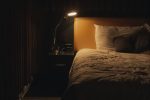Welcome to the 21st century, where we demand so much more of our furniture beyond just holding us up. We expect furniture to be therapeutic as well. Not just in the physical sense, but new designs in comfort technology have to be mentally soothing as well, promoting the flow of happy neurotransmitters to the brain. Surprisingly enough, there is some merit to the idea.
What Science Has To Say
More attention has been focused lately on the relationship between physical activity and mental well-being. For example, we’ve seen a lot of research pointing to physical exercise and its impact on mental well-being. We have also seen that people with autistic spectrum disorder benefit from deep pressure stimulation, which works to calm and comfort over-stimulated brain functions. There’s even people who claim to get a pleasurable response from viewing videos with people whispering and doing tactile things like brushing wool or sifting sand: Just type “ASMR” into YouTube to see what this is about.
Deep pressure stimulation has also been studied recently at the occupational therapy department of the University of Alabama, Birmingham. They did find some beneficial responses to anxiety in response to this sensation. Other applied behavior therapists have formed a movement around these new discoveries of the subtle links between mental state and physical sensations. We don’t even know how most of this works, only that it does.
Stress-Testing a Beanbag
Among the inventors and manufacturers of devices and furniture for those with special needs, there’s John Fiorentino. He’s previously had success with a weighted blanket called the Gravity Blanket, for applying deep pressure therapy for the sleeping needs of those with autism. He’s now back with Moon Pod, a very high-tech “beanbag” furniture unit with a flexible blob shape that tackles the same kind of task, only from the opposite direction.
Moon Pod is built out of a high-friction filling and a stretchy outer material to act as the world’s most supportive full-body furniture. Fiorentino calls this idea “zero-gravity,” because this beanbag recliner is built to feel like you’re floating in it, with a firm but light touch that keeps you snuggled all around, providing deep pressure sensations that are more like flotation therapy.
The Moon Pod has gotten popular enough that it’s sold on Amazon, Walmart and eBay, so enough people must see something in it. We can’t speak for anxiety sufferers, but from people who have tried it, we can confirm that it does eliminate all pressure points, distributing weight evenly while supporting the body. It’s not like an air mattress, a stuffed Ottoman, a waterbed or even any other beanbag. The Moon Pod is made out of researched materials to give just the right amount of resistance.
While nobody’s recommending Moon Pod or even the Gravity Blanket as a miracle cure, there is plenty of commonsense science to back up the idea of fighting stress by being comfortable. Being able to lie loosely, supported but unencumbered, is good for airflow and circulation. Being comfortable also reduced the levels of the stress hormone cortisol.
Theories
Why do things like flotation therapy and deep pressure stimulation work? We’re years from figuring this out, but some experts speculate that it’s something deep in our primal mechanisms. Babies get comfort from being swaddled, hugged and held, to the point where denying them physical touch actually causes long-term development issues.
Just as exercise helps fight depression because our primitive ancestors evolved to stalk the grassy savannas instead of being crammed into a car all day, perhaps there could be evidence way back in our evolution that says collapsing into a big pile of hay was the best way we could sleep. The relationships between the physical and mental are so tenuous that we might always be guessing about the underlying neurological structure.
One thing is certain: If you find a more comfortable way to rest and it helps you sleep better, there’s a lot of stress-relief right there.
















